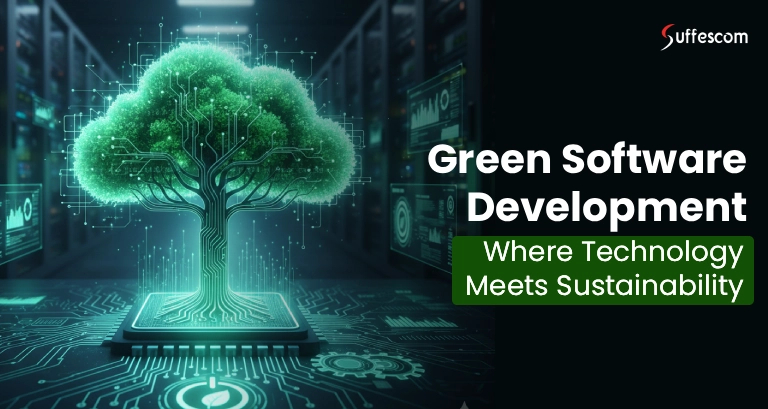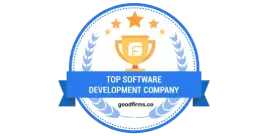Green Software Development: A Sustainable & Profitable Business Move for 2026

The tech industry isn't doing enough! Yes, you have heard us right. It has made our lives much more convenient, but there's a price for that convenience: our planet. Wait! Do not skip. This isn’t another environmental activism blog that rants about “how technology is destroying the earth,” but do not offer any real-world solutions.
Belonging to the tech industry ourselves, we don’t talk without evidence or a solution. If you are here, whether you are a business owner, an entrepreneur, or even a software developer, you will find a solution.
Now, let’s jump straight to the point. As per recent research, the ICT (Information & Communications Technology) sector is responsible for 4% of global GHG emissions. That is even higher than what the international aviation industry produces. Yes, it is shocking. Behind every YouTube video streaming, post liked, and food ordered lies energy consumption. If not monitored, it often results in large carbon footprints. So, what's the solution? How can tech companies actively contribute to sustainability without adjourning their production?
By simply switching to green tech. Sustainability doesn't mean putting an industry out of business. It's about making thoughtful adjustments for a healthier environment. As a first step, you can start with green software development. The very same software, but more eco-friendly.
What is Green Software Development?
Green software development is a process in which technical practices are revised to ensure the software produces significantly fewer carbon emissions while delivering high-quality performance.
In simple terms, whenever software is created, it requires a significant amount of energy to generate code, design user interfaces, develop features, integrate APIs, etc. This energy comes directly from electricity that comes from coal. That’s why traditional methods of software development are considered not environmentally friendly.
On the other hand, in the development of green software, sustainable methods and tools are taken into use, such as energy-efficient programming languages, carbon-emission monitoring, serverless architecture, and more. It results in mindful consumption of resources and energy while maintaining performance quality.
Build Eco-Friendly Digital Solutions Today
Start adopting low-carbon software practices that minimize energy usage and optimize performance. Our experts help you design sustainable, scalable, and environmentally responsible digital products aligned with 2026 sustainability standards.
Green Software vs. Traditional Software Development: Side-by-side Comparison
For a clearer understanding, we have created a table comparing different aspects of both development processes.
| Aspect | Traditional Method | Green Method |
| Energy Use | Large-scale consumption of energy | Highly energy efficient |
| Resource Use | Extensive use of resources | Limited resource used |
| Carbon Emission | Often causes high carbon emissions | Significantly less carbon emissions caused |
| Development Approach | Quality and speed | Efficiency, quality, sustainability |
| Code Efficiency | Often includes unnecessarily long and complex coding | Codes are easy and efficient |
| Tools | Traditional tools only deliver functionality. | Greentech tools are used that deliver high performance and require limited energy consumption. |
| Cost | Costs are typically high due to excessive usage of energy and resources | Cost-effective for being highly energy and resource efficient. |
| Business Impact | Can only meet product-related needs. | Meets both the business success parameters, that is, improved product quality, and a competitive edge for being a green solution. |
Why Smart Businesses Are Switching to Green Software Development & You Should Too?
It is estimated that by 2027, almost 30% of large enterprises will switch to green software development practices. Microsoft, a tech giant previously questioned for its high carbon emissions (2.6 million metric tons in 2020), has set a goal to become carbon negative by 2030. The efforts are already showing. Their carbon emissions graph has come down to 1.757 million metric tons in 2024.
But why this sudden shift to sustainability? Because the consumer base is shifting towards making green choices. Stats show that 72% customers are willing to pay more for sustainable products. This marks the dynamic shift in consumer needs and product development.
Now, brands must come up with more innovative products that not only deliver high-quality solutions to large social problems but are also 100% eco-friendly. However, the primary reason behind brands shifting to green software solutions isn’t just customer retention, but other benefits as well, which are:
Responsibility towards Sustainability
The most prominent reason behind companies choosing green tech solutions is to fulfil their social and environmental responsibilities in the most effective way. Let us decode this for you. Previously, to practice sustainability, a brand focused solely on philanthropic activities.
But by switching to green software development, they implement sustainability in their real workflows. It counts as a more active practice, attracting a larger audience.
Resource Efficiency
Building green software requires minimal resource consumption, including CPU, data storage, and network bandwidth. Over the combined years, this limited consumption helps companies save a significant amount on cloud bills, electricity, infrastructure costs, and more.
Enhanced Performance Quality
It includes a light-weight architecture, efficient code, and limited resource usage. It leads to faster, more responsive platform performance, further leading to improved brand reliability.
Long-term Stability
Green software is far more adaptable to improvements. In traditional platforms with complex architecture, scaling often becomes a time-consuming process, adjourning workflows. But the crisp and smooth architecture of green software enables brands to make improvements even in fast-paced environments.
Smoother Operations
The development practices also include automation, energy monitoring, and related measures. This helps teams better track energy consumption and make necessary adjustments, resulting in seamless and high-quality deployments.
Competitive Edge
As previously mentioned, adopting sustainable products and workflows within the system empowers the brand to stand out as innovative, responsible, and future-proof. This further helps them attract an eco-conscious customer base and also gain an instant competitive advantage.
Is Green Software Development Actually Implementable?
Some companies are still reluctant to adopt similar practices because they don't seem practical. To get hold of the actual scenario, we did a survey. We interviewed some industry experts, business owners, and developers, and asked for their opinions on green software.
While some developers responded positively and seemed quite aware of the subject, most countered with one question: "Even if I decide to go green, how is it possible to take care of numerous small aspects of software development that consume energy?”
To be honest, that's a valid question. Building green software appears to be a simple process in theory. However, the practical implementation unfolds multiple challenges, such as a lack of market awareness, skill set, tools, etc.
Just as with challenges, solutions are also real. By adopting modern age technologies, light-weight architecture, and consistent optimization, companies can effectively achieve their goals.
For example, we have recently developed a green meme coin for one of our clients. This coin is a cryptocurrency that promotes environmentally sustainable actions using the power of social media, especially the meme culture. In short, it transforms saving the planet from just being a responsibility into a fun and profitable action.
So, the final answer is yes. Building green software is 100% implementable, and companies do not require a ton of investment or a change to the entire workflow to achieve it. We have been doing it, and so can you.
The Core Principles of Developing Green Software
In any software development process, companies follow a set of key principles or guidelines that help maintain consistency with product quality and the business agenda. Building eco-friendly software is no exception. These 7 principles will help you incorporate sustainability into your software more effectively while also adhering to functional requirements.
Carbon Footprint Awareness
The first principle of building eco-friendly software is to be aware of the carbon footprint caused in the development process. Every data transfer, code running, or integration consumes energy and further produces CO2 emissions. Companies need to constantly monitor and incorporate advancements to reduce emissions as much as possible.
Electricity Consumption Awareness
The next one is electricity monitoring. As you might have guessed, it’s the practice of measuring how much electricity a software application consumes to run various functionalities and making adjustments in the development process to minimize that consumption.
Network Optimization
It refers to monitoring how much energy software consumes for processing data. Large, frequent data transfers increase energy consumption. Companies can optimize data size and transfer frequency to use energy more efficiently.
Hardware Efficiency Optimization
Software uses hardware components such as CPUs, RAM, GPUs, etc., to run operations. Optimizing hardware efficiency simply means adopting software development practices that reduce the hardware's workload.
Energy proportionality
Energy proportionality stands for redesigning how your software or hardware uses energy. Traditional software consumes energy even when idle, which adds to carbon emissions. Therefore, companies must find ways to ensure software consumes energy only when operating at full capacity, thereby reducing emissions.
Demand Shaping
This is about prioritizing functional demands based on the availability of clean energy (energy generated from renewable sources). It means operating non-urgent workflows, such as data backups or analytics, using clean energy only while executing other urgent operations as needed.
Lifecycle optimization
Lifecycle optimization refers to optimizing the environmental impact throughout the entire software development process. Whether it’s the core development, deployment, or maintenance, the companies must take care of their carbon footprint and make adjustments across workflows.
Must-follow Green Software Development Practices for a Successful Deployment
Do you remember our survey? People that we interviewed didn’t question why they should switch to green software; they asked how. It's because they weren’t aware of the practices to be followed. This section is about the same; we will discuss the top 10 development practices that make software green.
Energy Efficiency Monitoring
Invest in energy-tracking and carbon footprint monitoring tools to measure how much energy your software consumes for various actions and the associated carbon footprint. Based on the results, make needed revisions in the process, such as eliminating retarded components, optimizing execution times, scheduling high-consumptive tasks in clean energy time, etc.
Efficient Data Management
Reduce data load and redundancy by implementing practices such as regular audits, file compression, minimizing duplicate queries, and caching layers. These combined ensure that data flows efficiently across networks without putting too much strain on the hardware.
Code Reduction
Long and complex codes consume more energy to process data. Consistently review codes to eliminate dead code, simplify complex designs, and refactor heavy modules. These revisions reduce computation per request, further enhancing software efficiency.
Load balancing
Include load-balancing devices in the workflows to ensure equal distribution of network traffic across various servers. It eliminates strain on any one server during high-volume usage, leading to longer hardware durability. Apart from that, load balancers also enable these servers to consume power only when in use, significantly reducing energy consumption.
Process Optimization
Eliminate redundant components, automate repetitive actions, and simplify overly extensive workflows to improve efficiency. Remember, the cleaner and more efficient the deployment process is, the less energy it consumes.
Resource-efficient Programming Languages
Incorporate the use of programming languages that use the least energy while running heavy actions. You can test-run with various language models to see which one uses the least resources per execution and what the output quality is, to find the best match for your software.
Code Analysis Tools
Including code analysis tools in the workflow can help you gain real-time insights into excessively long or complex code, code duplication, energy-intensive patterns, etc. This allows developers to optimize their coding modules without multiple rounds of manual testing.
Serverless Architectures
Switch from always-on server architectures to serverless architectures, as they are not only lightweight but also highly efficient in energy consumption. These servers enable event-driven code execution, meaning the system consumes power only when running at full capacity, not when idle.
Green Frameworks
Use low energy-consumptive backend frameworks, which help reduce CPU work, bundle sizes, rendering time, and more. As backend workflows often involve complex functions, green frameworks can be highly useful for maintaining quality and speed even under restrictive energy constraints.
Automated Testing
Rather than manual QA testing, switch to green automation. Such systems schedule testing workflow in clean energy time and also perform only the necessary tests. It helps in significantly efficient use of energy.
Note: This doesn’t describe the entire development process but only talks about the aspects that undergo revisions and advancements to suit the agenda of sustainability.
Go Green With Smarter Software
Cut energy usage and boost efficiency with eco-friendly development practices tailored for future-ready businesses.
Top Green Tech Tools Powering Sustainable Software Development
We have gone through the principles, best practices, and every piece of information a business needs to know about the technicalities of green software. Now, let’s discuss the actual things that make green software a reality. Yes, they are green tech tools. To make you understand better, we have created a table of each development practice and the respective tools used.
| Green Development Components | Tools Used |
| Energy efficiency monitoring | AI energy efficiency monitoring tools, SCI, Cloud carbon footprint, Kepler, Power API, etc. |
| Efficient data management | Apache Kafka, Apache Parquet, Snowflake, DataOps.live, etc |
| Code reduction | Webpack, Tree Shaking, ESBuild, Rollup, SonarQube, UglifyJS, etc. |
| Load balancing | NGINX, NGINX Plus, HA Proxy, AWS ELB, etc |
| Process optimization | Jenkins pipeline optimization tools, GitHub Actions, Datadog APM, etc. |
| Resource-efficient programming languages | Rust, Go, Sevelte Compiler, NIM, etc. |
| Code analysis tools | ESLint, PYlint, JetBrains IDE Inspections, etc. |
| Serverless architectures | AWS Lambda, Azure Functions, Google Cloud Functions, etc |
| Green frameworks | Astro, Svelte, Django, Fastify, etc. |
| Automated testing | JUnit, PyTest, TestRail, Selenium Grid, etc |
Upcoming Innovations in the Green Software Industry
Looking at the larger picture, we might have just taken baby steps towards green tech. The industry is evolving rapidly, expanding its horizons into leading technologies such as:
AI for Sustainable Architecture
Sustainable AI, or green AI, will be used to reduce the carbon footprint of traditional AI models while also using the same technology (Artificial Intelligence) to improve sustainable practices in other sectors.
Innovations:
- AI for carbon tracking
- Carbon-aware scheduling
- Development of energy-efficient AI models
Quantum Computing
Researchers have found that quantum computing can process vast amounts of complex data far more efficiently than traditional computers. This can be utilized to create more sustainable systems.
Innovations:
- Material discovery
- Complex system optimization
- Faster climate modeling
- Energy-efficient computation
Lifecycle Assessment tools
These tools will provide real-time insights into a company's energy consumption, CO2 emissions, resource use, and more. It enables them to make more informed and successful decisions towards sustainability.
Innovations:
- Eco-design integration
- Standardization
- AI automation
SaaS Platforms
Green SaaS platforms are providing a complete green ecosystem to businesses. With readymade tools, sustainable architectures, automated workflows, and carbon-aware load balancing, companies can deploy fully sustainable products much faster.
Innovations:
- ESG platforms
- GreenOps
- Carbon-aware computing
- Code audits
Limitations of Developing Green Software and How Companies Can Overcome Them Easily
Tech companies, going sustainable is the demand of the time, but the fact that sustainable tech practices are still challenging can't be denied. Perhaps this is why even tech giants like Microsoft are doing small, gradual changes. But a small change is still a change, and far better than no change at all, isn't it?
Moreover, these challenges are not big enough to stop the sustainable movement. With the right strategy and utilization of resources, any software development company can build its first-ever green software. That being said, let's discuss some of the popular challenges that come in the way and how you can overcome them.
Higher Upfront Investment
Challenge:
Developing green software often requires a high initial investment in setting up systems, purchasing tools, reorganizing workflows, upskilling developers, etc. Managing all of this at once might disrupt existing efficient workflows and affect ROI.
Solution:
Becoming sustainable doesn’t mean changing every inch of workflows. Companies can adopt green tech step-by-step. Simply start with clean coding, eliminating redundant components, allocating resources efficiently, etc. All these small changes, combined, will surely give you a measurable result. As you improve, try to incorporate advanced practices such as energy monitoring, efficient coding modules, and more.
Lack of Awareness or skillsets
Challenge:
The most common challenge tech organizations face with green tech practices is the lack of employee skill sets. Some developers are aware but haven’t been practicing similar technologies, while others remain comfortable with traditional processes.
Solution:
No need to go all in at once. Asking working professionals to adapt to an entirely new workflow all of a sudden isn’t fruitful. Sustainability also means creating a safer environment for human resources to upskill. Therefore, it is important to gradually introduce new concepts, provide training, and then put the skills into use.
Lack of Resources
Challenge:
Though theory-based data is available in abundance, the actual tools to incorporate green tech into the process are limited. It leads to compromises in accuracy and disruptions.
Solution:
If a company has the budget to invest in the tools currently available in the market, it will be enough. But even if they don't, it is advisable to keep going with the existing ones. Sustainability is about making environmentally friendly decisions with whatever resources you can afford. Moreover, the industry is still evolving, with new technologies emerging, so we can continue to grow.
Performance downtime
Challenge:
To make efficient use of energy, some green architectures can limit CPU workload, thereby delaying data processing.
Solution:
By implementing innovative practices such as load balancing, regular audits, and caching, companies can significantly improve network efficiency. Additionally, you can use performance optimization software for a smooth experience.
Complex implementation of legacy systems
Challenge:
Transforming traditional softwares to a green architecture requires redesigning code, implementing energy monitoring, optimizing workflows, etc., which can introduce unwanted complexity.
Solution:
Rather than changing every inch of the software, companies can make gradual progress. For example, they can start by removing duplicate codes and gradually move on to simplifying complex coding modules and implementing energy monitoring.
Dependency on cloud service providers
Challenge: Green software heavily relies on external servers, which don’t always participate in sustainable practices.
Solution: Companies can choose greener cloud service providers that offer green regions, transparent monitoring, load balancing, and more.
Organizational Resistance
Challenge: Not all professionals might be open to adopting sustainable workflows. This can lead to misalignment in the decision-making process, often resulting in the dismissal of new ideas.
Solution: Companies need to present the benefits of green tech to professionals first, such as lower cloud bills, automation, and reduced workload. These small benefits help them gain trust faster and adapt to gradual advancements more easily.
Limited Industry Options
Challenge: The green tech industry is still evolving. It is hard to find principles or best practices to follow.
Solution: It is true that the industry is evolving, and there are limited case studies. But companies can still start their sustainable software development journey with globally available resources. Moreover, with consistent practice, they can discover their own efficient sustainability principles.
How can Companies Begin with Green Software Development for the First Time?
Transforming from traditional development practices that we have been working on for years to eco-friendly solutions can be overwhelming. Therefore, it is important to adopt the right strategies that make our transition smoother and fun.
Start by measuring your carbon footprint. There are plenty of tools available to measure how much carbon emissions your usual software development process is causing. It will help you have a better understanding of which components you need to put more effort into.
Second, train your team for the transition. In the end, it’s your team that’s going to handle all the workflows. Therefore, always ensure they are confident enough to transition towards sustainability. No need to launch a new set of strict policies; this can worsen the situation.
Gradually introduce the concept to your team through meetings, activities, and like-minded group discussions. It would be best if you made the policies together.
Third, start adopting gradually. This is where most companies get stuck. They usually try to go all in at once, leading to nothing but confusion. Sustainability isn’t about rushing things. Educate yourself about the practices, the technologies, case studies, etc., first. After that, choose one component to make it greener. It can be codes, data management, etc.
It’s okay if you fail for the first time; revise your practices and try again. It is not a competition.
As the fourth step, take one project to begin with. No need to start with a completely unfamiliar project. For example, take up a familiar model and then try to make it greener, like MVP app development. As we all know, MVP apps have fewer features and a flexible architecture. This way, it is easier to embed carbon-efficient components in this app.
Fifth, create your own green development framework. Global principles are generic. They might not perfectly fit your needs. Therefore, start by experimenting with various practices and, based on the results, create a set of best practices and follow them for future projects.
Hire a development company to streamline processes. If you can’t manage to do the above-mentioned things for whatever reason, just ask a development company to build green software for you. It’s much more cost-effective that way, since you wouldn’t have to do everything on your own.
Suppose you want to launch a green mobile app for your brand. Rather than hiring individual developers and marketers, find a reliable mobile app development company that offers sustainable solutions.
Go Beyond Software: Build a Sustainable Tech Ecosystem
We have discussed enough about the green software revolution and how you can also take your first steps towards sustainable tech. Now that we are already discussing sustainability, let us explore what more tech companies and businesses can do to create a fully sustainable ecosystem.
Invest in renewable energy
Start creating a budget to invest in renewable energy. The most accessible one is solar energy. Installing solar panels at your workplace can not only help you save on high electricity bills but also accelerate your software development process. This way, you wouldn’t have to constantly monitor coal-based energy consumption.
Adapt to a sustainable IT infrastructure
Instead of being limited to software development, you can expand the green practices across various business operations, like adopting sustainable cloud structures, energy-efficient CPUs, eliminating redundant or high-energy-consuming devices, etc.
Involve in socially sustainable activities
Involving in socially sustainable activities can help businesses create a strong, responsible, and ethical brand image. Additionally, these frequent activities diversify mundane workflows. It makes employees feel more valuable, improves work satisfaction, and therefore, employee retention.
Implement Sustainable Procurement Policies
Create guidelines, source sustainable goods, and reevaluate your suppliers to minimize your organization's carbon emissions. It can help you reduce your carbon footprint even outside the core workflows.
Partner With Experts in Green Software Development
Accelerate your shift to sustainable tech with a team specializing in low-energy, high-impact digital solutions.
Conclusion
This is how we came to the end of the blog, where we discussed topics such as green software, core principles, best practices, initial steps, and more. If you are still giving sustainability a second thought, you shouldn't. Your competitors might already be implementing practices; it's high time you should too!
Eco-friendly development practices aren't just about the planet; they're also about keeping up with consumer needs. We all know the golden rule: the better your products adapt to customer needs, the more you grow.
Frequently Asked Questions
Are there any Green Software in the market?
There are multiple green software available in the market used for greentech practices. They are as follows:
- Carbon Aware SDK
- Cloud Carbon Footprint
- Greentally
- Breathe ESG
- Ecodesk
- RETScreen Expert, and more.
Cost of Green Software Development?
The development cost of green software depends on factors such as software type, features, integrations, and scalability. The standard market price starts from 20,000 USD and can range higher based on your needs.
How to Develop Green Software for the First Time?
Do your research about the software, best practices, and core principles. Then prepare a step-by-step workflow. After that, Purchase tools that help with those practices, and lastly, train your team.
Best Green Software Development Company?
Suffescom Solutions is the best green software development company. It has 13+ years of industry experience and has served 1,250+ clients worldwide. They are among the few software development companies actively pursuing eco-friendly software development practices.
Is Green Software Durable?
Yes, this is one of the benefits of green software. Such development practices focus on energy efficiency and lightweight infrastructure, which ultimately extends the life of the product.






